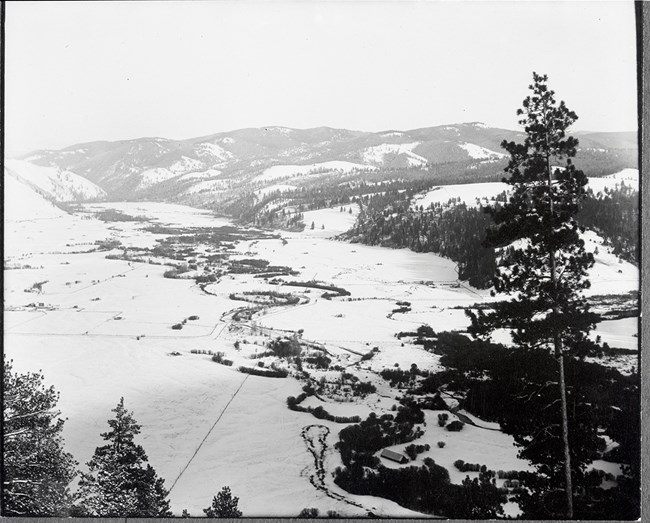Last updated: January 14, 2025
Article
Ross’ Hole—Indigenous Nations Address Climate Change in the Intermountain West

University of Montana Mansfield Library
On September 4, 1805, hungry and cold expedition members struggled down the north slope of the Bitterroot Mountains from Lost Trail Divide into an open valley, later named Ross’ Hole. Some 400 Salish people were camped in the valley, on their way to hunt bison with the same Shoshone people Lewis and Clark had just left. Offering a warm welcome, the Salish fed the explorers and traded gifts and goods with them.28
Part of the expedition’s purpose was for Lewis and Clark to be the United States’ ambassadors to the Indigenous nations they met along the way. To ease diplomatic relations, the expedition brought gifts, including several types of peace medals to bestow upon Tribal leaders. Although they were trying to project authority, the explorers relied on help from many Indigenous groups, such as the Shoshone, Nez Perce, and Salish, to survive and to succeed in their mission.29
Many of the groups Lewis and Clark met with still exist as sovereign nations. As part of their governing responsibilities, they are trying to protect their people and resources from the effects of climate change. The Upper Snake River Tribes Foundation (which includes the Shoshone) has recognized many impacts of climate change, including drying sagebrush steppe habitat, longer wildfire seasons, low summer river flows, higher water temperatures, and degraded rangelands. The Nez Perce have developed a climate change adaptation plan that includes carbon capture, natural resource inventories, and forest health and stream flow monitoring. The Confederated Salish and Kootenai Tribes have developed a Climate Change Strategic Plan. This plan includes gathering ecological knowledge from Tribal elders that, in their oral tradition society, reaches back 250 years or more. It addresses issues with air quality, forestry, fish, infrastructure, lands, people, water, and wildlife.30
Citations:
28 Joseph A. Mussulman, “The Lost Trail Divide,” Discover Lewis & Clark, accessed August 26, 2024, https://lewis- clark.org/the-trail/lemhi-and-bitterroot-valleys/lost-trail-divide/; NPS, “Ross’ Hole,” Lewis & Clark National Historic Trail, last updated November 27, 2020, https://www.nps.gov/places/ross-hole.htm.
29 “Discovering Diplomacy,” Rivers, Edens, Empires: Lewis & Clark and the Revealing of America, Library of Congress, accessed August 26, 2024, https://www.loc.gov/exhibits/lewisandclark/lewis-landc.html; NPS, “Washington Medals Used by Lewis and Clark,” Lewis & Clark National Historic Trail, last updated July 1, 2020, https://www.nps.gov/articles/000/washington-medals-used-by-lewis-and-clark.htm; Rod Gragg, Lewis and Clark on the Trail of Discovery (Nashville: Rutledge Hill Press, 2003), 33. 30 Upper Snake River Tribes Foundation, “Upper Snake River Tribes Foundation Climate Change Vulnerability Assessment” (February 2017), https://uppersnakerivertribes.org/wp-content/uploads/2016/10/USRT.CCVA_.pdf; Nez Perce Tribe, “Climate Change,” accessed August 26, 2024, https://www.nptwaterresources.org/climate-changeprogram/; Confederated Salish and Kootenai Tribes of the Flathead Reservation, “Climate Change Strategic Plan,” revised August 2020, pp. 28, 33, https://drive.google.com/file/d/1q6eBDCrBz3kxcdgFtxLxpqf8qeK89Oth/view.
